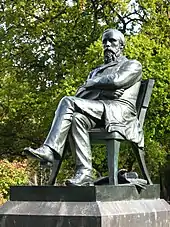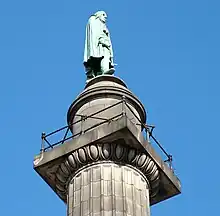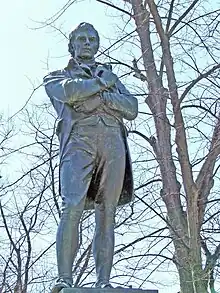_by_Thomas_Alexander_Ferguson_Graham_(1840%E2%80%931906).jpg.webp)



George Anderson Lawson (Edinburgh 1832 – 23 September 1904) was a British Victorian era sculptor who was associated with the New Sculpture movement.
Life
He was born at Edinburgh in 1832, the son of David Lawson and Anne Campbell. He was educated at George Heriot's Hospital. He trained under Alexander Handyside Ritchie, and in the schools of the Royal Scottish Academy.[1] Lawson travelled to study in Rome, becoming an admirer of John Gibson.
Back in England, he lived initially in Liverpool, making work in terracotta. His reputation was established through the creation of statues of distinguished citizens. His first major work was the statue of the Duke of Wellington at the top of Wellington's Column in the centre of Liverpool at the end of William Brown Street. He also created the relief sculpture depicting Wellington's major victory at Waterloo. The monument was completed "towards the end of 1865 when George Lawson's relief panel of the final battle at Waterloo was fixed in place on the pedestal".[2] He moved to London in 1866.
He later created the memorial to Robert Burns in Ayr, inaugurated in 1892. Other versions were circulated to Dublin, Melbourne, Montreal, Winnipeg, Halifax and elsewhere. Other memorials include those to James Arthur (Glasgow), Joseph Pease (Darlington), John Vaughan (Middlesbrough) and John Biggs (Leicester). In New Zealand, he commemorated William Sefton Moorhouse in Christchurch.
He is also remembered for his classical friezes, especially reliefs for Glasgow City Chambers, George Square, and panels for the Municipal Buildings, Bath. The art critic Marion Spielmann described his work as "strong, manly and artistic".[3]
Lawson was elected an Honorary Academician of the Royal Scottish Academy (HRSA) in 1884.[4] He died at Richmond, Surrey, on 23 September 1904.[1]
Family
On 28 August 1862, he married Jane Frier of Edinburgh.[1]
Gallery
 Portrait of George A. Lawson by Thomas Alexander Ferguson Graham (1882), Aberdeen Art Gallery
Portrait of George A. Lawson by Thomas Alexander Ferguson Graham (1882), Aberdeen Art Gallery Motherless, a statue of a motherless girl and her father. George Anderson Lawson, 19th century. The Kelvingrove Art Gallery and Museum, Glasgow, UK
Motherless, a statue of a motherless girl and her father. George Anderson Lawson, 19th century. The Kelvingrove Art Gallery and Museum, Glasgow, UK William Sefton Moorhouse
William Sefton Moorhouse Wellington's Column, Liverpool
Wellington's Column, Liverpool Relief on Wellington's Column
Relief on Wellington's Column Burns, Ayr
Burns, Ayr Burns statue in Victoria Park, Halifax, Nova Scotia
Burns statue in Victoria Park, Halifax, Nova Scotia Portrait bust of John Pettie
Portrait bust of John Pettie Motherless (1897), Homewood Cemetery, Pittsburgh, Pennsylvania
Motherless (1897), Homewood Cemetery, Pittsburgh, Pennsylvania
References
- 1 2 3 Fryer, S. E. (1912). . In Lee, Sidney (ed.). Dictionary of National Biography (2nd supplement). London: Smith, Elder & Co.
- ↑ Cavanagh, Terry, Public Sculpture of Liverpool, Liverpool: Liverpool University Press, 1996.
- ↑ Elizabeth Prettejohn, After the Pre-Raphaelites: Art and Aestheticism in Victorian England, Manchester University Press, 1999, p.243
- ↑ Nisbet, Gary. "George Anderson Lawson (1832-1904)". Glasgow: City of Sculpture. glasgowsculpture.com. Retrieved 4 May 2015.
External links
- George Anderson Lawson (1832-1904)
- Joseph Pease statue
- S. E. Fryer, rev. Robin L. Woodward. "Lawson, George Anderson (1832–1904)". Oxford Dictionary of National Biography (online ed.). Oxford University Press. doi:10.1093/ref:odnb/34445. (Subscription or UK public library membership required.)